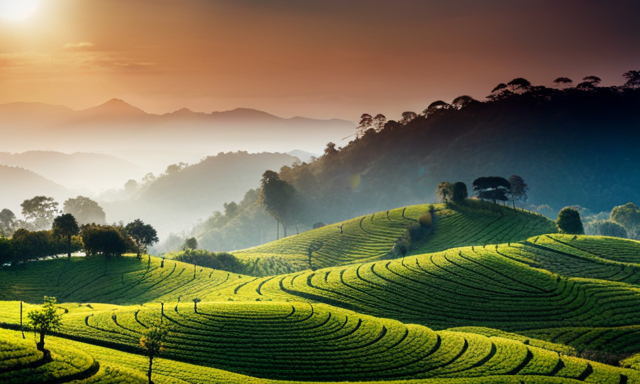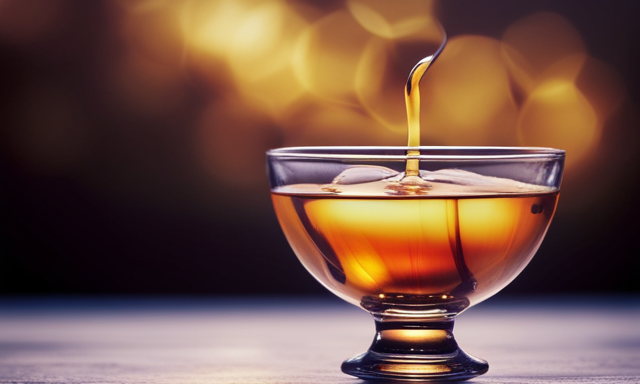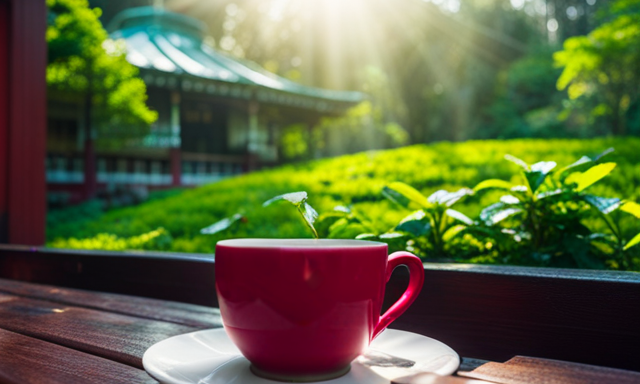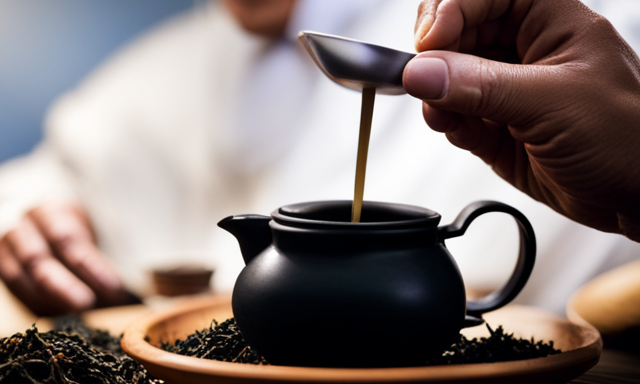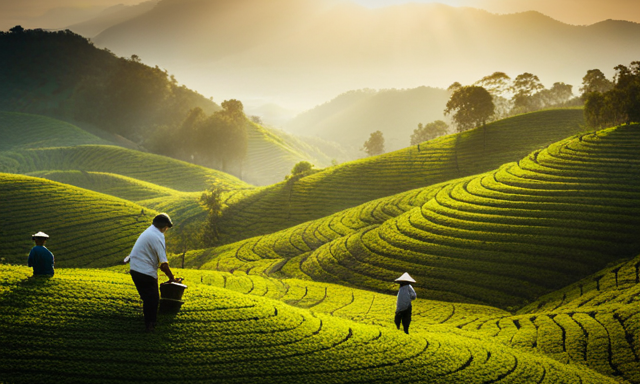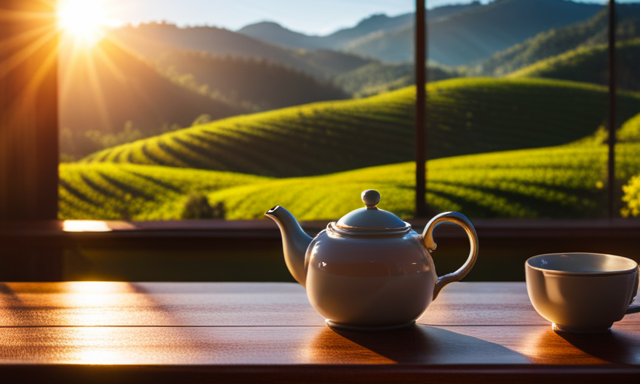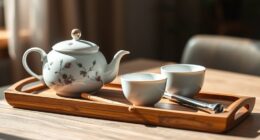Have you ever wondered where the tantalizing flavors of oolong tea come from? Well, prepare to be enlightened! In this article, I will unravel the mysteries behind this exquisite beverage and reveal the plant from which oolong tea is made.
Brace yourself for a journey into the world of Camellia sinensis, the tea plant responsible for producing this unique and flavorful tea. We’ll explore the fascinating process of harvesting and processing, as well as the diverse flavor profiles and aromas that make oolong tea so captivating.
Whether you’re a seasoned tea connoisseur or just starting your tea adventure, this article will provide you with the knowledge and insights you need to appreciate the complexities of oolong tea. So sit back, relax, and get ready to embark on a tea-infused voyage like no other!
Key Takeaways
- Oolong tea is made from the Camellia sinensis plant.
- The plant varieties used in oolong tea production include Tie Guan Yin, Da Hong Pao, Oriental Beauty, Jin Xuan, and Dong Ding.
- The quality of tea leaves directly affects the flavor of oolong tea.
- Choosing high-quality tea leaves ensures a better overall enjoyment of oolong tea.
The Origins of Oolong Tea
Have you ever wondered where that delicious oolong tea you love so much actually comes from? Well, let me tell you about the origins of oolong tea.
Oolong tea has a fascinating history that dates back centuries. It originated in China during the Ming Dynasty and is known for its unique production process.
Oolong tea is made from the leaves of the tea plant, Camellia sinensis. This plant is cultivated in specific regions with the ideal climate and soil conditions for tea production. The cultivation of oolong tea requires careful attention to detail, including the timing of harvesting and the precise method of processing.
Once the tea leaves are harvested, they undergo a partial oxidation process, which gives oolong tea its distinct flavor and aroma.
Now, let’s dive into the fascinating world of the tea plant: Camellia sinensis.
The Tea Plant: Camellia sinensis
Explore the captivating world of oolong tea, crafted from the leaves of the enchanting Camellia sinensis. This remarkable plant is cultivated in various regions around the globe, with each location imparting its unique characteristics to the final product.
-
Tea Plant Cultivation: The cultivation of Camellia sinensis requires specific conditions, such as well-drained soil, ample sunlight, and moderate temperatures. These factors ensure the plant thrives and produces high-quality leaves for oolong tea production.
-
Tea Plant Varieties: There are several varieties of Camellia sinensis, including the China variety, known for its delicate flavor and aroma. The Assam variety, on the other hand, boasts a robust and malty taste. Each variety contributes distinct nuances to the oolong tea experience.
As we delve into the fascinating process of harvesting and processing, we will uncover the meticulous steps involved in transforming these exquisite leaves into the delightful oolong tea that we savor.
Harvesting and Processing
Get ready to experience the artistry behind harvesting and processing oolong tea, as you witness the meticulous steps that transform these enchanting leaves into a delightful beverage that will captivate your taste buds. The quality of oolong tea greatly depends on the harvesting techniques and tea processing methods employed. Farmers carefully hand-pick the tea leaves, selecting only the most tender and mature ones. These leaves are then withered under controlled conditions to reduce moisture content. The next step involves tossing or shaking the leaves to bruise the edges, which initiates oxidation. This oxidation process is halted at a specific point, determined by the desired flavor profile. Finally, the leaves are fired to stop the oxidation and preserve the tea’s unique characteristics. These precise techniques result in oolong tea’s diverse flavor profiles and aromas, ranging from floral and fruity to toasty and earthy, making it an incredibly versatile and captivating beverage.
Flavor Profiles and Aromas
Indulge in the captivating world of oolong tea as its diverse flavor profiles and enchanting aromas transport you to a sensory paradise. Oolong teas offer a wide range of flavors, from floral and fruity to nutty and toasty. Each sip unveils a new layer of complexity, making it a delight for the taste buds.
To further entice your palate, here are five intriguing flavor profiles to explore:
- A creamy and buttery oolong with hints of milk and honey.
- A floral oolong with notes of orchid and jasmine.
- A fruity oolong with accents of peach and apricot.
- A roasted oolong with a nutty and caramelized flavor.
- A smoky oolong with a rich and earthy taste.
These flavor profiles can be enhanced through different brewing techniques, such as adjusting the water temperature or steeping time. As we delve into the art of brewing oolong tea, prepare to unlock a world of fragrant brews that will elevate your tea-drinking experience.
Brewing Techniques
Discover the art of brewing oolong tea as you perfect the techniques that will unlock the full potential of its flavor and aroma. Brewing oolong tea requires careful attention to brewing temperature and steeping time.
The ideal brewing temperature for oolong tea is around 190 to 200 degrees Fahrenheit, which is just below boiling point. Steeping time can vary depending on personal preference, but generally, 3 to 5 minutes is recommended for a balanced and flavorful cup of oolong tea. Longer steeping times can result in a stronger and more robust flavor.
As we move into the next section about the health benefits of oolong tea, it’s important to note that brewing techniques play a crucial role in extracting the beneficial compounds from the tea leaves.
Health Benefits of Oolong Tea
Oolong tea offers numerous health benefits, including its antioxidant properties. Antioxidants help protect our cells from damage caused by free radicals, reducing the risk of chronic diseases such as heart disease and certain types of cancer.
Additionally, oolong tea has been studied for its potential weight loss effects. It may help boost metabolism and increase fat burning.
Antioxidant properties
Imagine yourself savoring the rich flavor of oolong tea, derived from the leaves of the Camellia sinensis plant, while benefiting from its powerful antioxidant properties. Oolong tea contains a variety of antioxidants that help protect the body against free radicals, reducing the risk of chronic diseases and promoting overall health and well-being.
Here are three ways in which oolong tea’s antioxidant properties can enhance your experience:
-
Boosts immune system: The antioxidants in oolong tea strengthen the immune system, helping the body fight off infections and diseases.
-
Improves skin health: Oolong tea’s antioxidants promote healthy skin by reducing inflammation and protecting against damage from harmful UV rays.
-
Enhances heart health: The antioxidants in oolong tea can help lower cholesterol levels and reduce the risk of heart disease.
As you explore the potential weight loss effects of oolong tea in the next section, you’ll discover even more benefits to enjoy.
Potential weight loss effects
Boost your weight loss journey with the potential slimming effects of drinking oolong tea, which has been shown to increase metabolism by up to 10% and burn an extra 200 calories a day. Incorporating oolong tea into your weight loss routine can provide numerous benefits. This traditional Chinese tea is rich in polyphenols, which help to boost fat oxidation and increase energy expenditure. Additionally, oolong tea contains catechins that aid in the breakdown of fat and inhibit the formation of new fat cells. To further enhance your weight loss efforts, consider pairing oolong tea with a balanced diet and regular exercise. By incorporating these weight loss tips and harnessing the potential benefits of oolong tea, you can achieve your weight loss goals more effectively. Transitioning into the next section, let’s explore the fascinating culture and traditions surrounding oolong tea.
Oolong Tea Culture and Traditions
Explore the rich and captivating culture of oolong tea, made from the leaves of the Camellia sinensis plant, as you dive into its fascinating traditions.
Oolong tea has a long history in Chinese culture and is often used in oolong tea ceremonies, where the preparation and serving of the tea is considered an art form. These ceremonies often involve specific rituals and etiquette, creating a serene and spiritual atmosphere.
Oolong tea is also highly regarded in Chinese medicine, where it is believed to have various health benefits, such as improving digestion and reducing inflammation.
In addition, oolong tea is known for its unique taste, which can range from floral and fruity to toasty and earthy. Its intricate flavors and aromas make it a favorite among tea connoisseurs.
As we move on to discuss oolong tea compared to other types of tea, it becomes evident that oolong tea holds a unique place in the tea world.
Oolong Tea vs Other Types of Tea
Step into the world of oolong tea and discover how it compares to other beloved types of tea. Oolong tea is known for its unique processing techniques, which give it a distinct flavor and aroma. Unlike black and green teas, oolong tea is partially oxidized, resulting in a flavor profile that falls somewhere between the two. This means that oolong tea offers a balance of the sweetness and floral notes found in green tea, as well as the rich and robust flavors of black tea. Additionally, oolong tea is packed with health benefits, including improved digestion, weight management, and enhanced mental alertness. Its processing techniques also contribute to its unique benefits, as the partial oxidation allows for the preservation of many beneficial compounds. Transitioning into the next section about popular oolong tea blends and flavors, it’s fascinating to explore the creative combinations that can be achieved with this versatile tea.
Popular Oolong Tea Blends and Flavors
Popular oolong tea blends and flavors are irresistible, captivating the palate with harmonious combinations and exquisite taste profiles.
Oolong tea comes in a wide range of flavors, each offering a unique sensory experience. The delicate floral notes of jasmine oolong and the rich and toasty flavors of roasted oolong are just a few examples. There is a taste for every tea enthusiast.
Oolong tea can be brewed using different methods, such as gongfu style or Western-style brewing. These methods allow you to customize the strength and flavor to your liking.
Whether you prefer a light and floral cup or a robust and nutty brew, oolong tea is sure to delight your taste buds.
Now, let’s explore where to buy oolong tea and discover the best sources for this exquisite beverage.
Where to Buy Oolong Tea
When it comes to buying oolong tea, there are a few options that I find reliable.
Specialty tea shops are a great place to start, as they often carry a wide range of high-quality oolong teas.
Online retailers are another convenient option, offering a vast selection and the convenience of home delivery.
To ensure you are getting the best oolong tea, remember to look for teas that are sourced from reputable regions and farms.
Consider trying different varieties to find the flavor profile that suits your taste preferences.
Specialty tea shops and online retailers
While browsing through specialty tea shops and online retailers, you’ll discover a vast selection of oolong tea made from different plant varieties. These establishments offer a wide range of choices, allowing tea enthusiasts to explore the diverse flavors and aromas of oolong tea. To provide a glimpse of the options available, here is a table showcasing some popular plant varieties used in oolong tea production:
| Plant Variety | Description |
|---|---|
| Tie Guan Yin | Renowned for its floral fragrance and smooth, buttery taste. |
| Da Hong Pao | Known for its rich, roasted flavor with hints of mineral notes. |
| Oriental Beauty | Exhibits a unique fruity flavor and a sweet honey-like aroma. |
| Jin Xuan | Offers a creamy texture and a pleasant milky aroma. |
| Dong Ding | Features a balanced flavor profile with floral and toasty notes. |
As you explore these specialty tea shops and online retailers, keep in mind that each plant variety offers its own distinct characteristics. Understanding these differences will help you select a high-quality oolong tea that suits your preferences. Now, let’s delve into some tips for selecting the perfect cup of oolong tea.
Tips for selecting high-quality oolong tea
To ensure you choose the perfect cup of quality oolong, consider these helpful tips:
- Look for oolong tea made from the Camellia sinensis plant, specifically the leaves and buds.
- Check the grade of the oolong tea. Higher grades, such as ‘fancy’ or ‘choice,’ often indicate better quality.
- Pay attention to the aroma of the tea. High-quality oolong tea should have a pleasant, fragrant scent.
- Examine the appearance of the leaves. They should be tightly rolled or twisted, indicating a well-processed tea.
- Consider the origin of the oolong tea. Different regions have different flavor profiles, so choose one that suits your preferences.
By following these tips, you can confidently select high-quality oolong tea that will provide a delightful and satisfying experience. Remember, the quality of the tea leaves directly impacts the flavor and overall enjoyment of your oolong tea.
Frequently Asked Questions
How is oolong tea different from green tea and black tea?
Oolong tea, unlike green or black tea, offers a unique taste and aroma. Its distinct characteristics set it apart from herbal tea and white tea. Let me explain the differences in detail.
What are some popular blends and flavors of oolong tea?
Some popular oolong tea blends include milk oolong, ti kuan yin, and jasmine oolong. Unique flavors of oolong tea can range from fruity and floral to toasty and nutty, offering a diverse and enjoyable tea experience.
Where can I purchase oolong tea?
You can purchase oolong tea from specialty tea shops, online tea retailers, and some grocery stores. It’s important to choose high-quality tea from reputable sources. Popular brands include Teavana, The Republic of Tea, and Harney & Sons.
Are there any health benefits associated with drinking oolong tea?
There are several health benefits associated with drinking oolong tea. It can boost metabolism, aid in weight loss, promote heart health, improve mental alertness, and strengthen the immune system. Oolong tea is produced through a specific process of withering, oxidation, and drying.
What are the traditional brewing techniques for oolong tea?
To brew oolong tea, traditional methods involve using high-quality oolong tea leaves and precise brewing techniques. These methods ensure that the tea is infused with the perfect balance of flavors and aromas, resulting in a delightful and aromatic cup of oolong tea.
Conclusion
In conclusion, oolong tea is a captivating beverage that offers a unique blend of flavors and aromas.
Made from the leaves of the Camellia sinensis plant, oolong tea has a rich history and a vibrant tea culture surrounding it.
With its distinct flavor profiles and intricate brewing techniques, oolong tea is a true delight for tea enthusiasts.
So, whether you’re a seasoned tea connoisseur or just starting to explore the world of tea, don’t miss the opportunity to savor this ‘hidden gem’ that will surely leave you craving for more.

